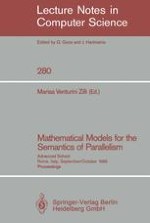1987 | Buch
Mathematical Models for the Semantics of Parallelism
Advanced School Rome, Italy, September 24 – October 1, 1986 Proceedings
herausgegeben von: Marisa Venturini Zilli
Verlag: Springer Berlin Heidelberg
Buchreihe : Lecture Notes in Computer Science
Enthalten in: Professional Book Archive
